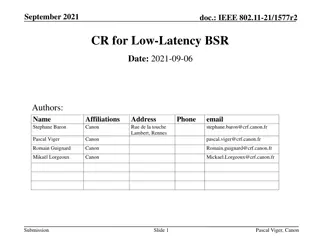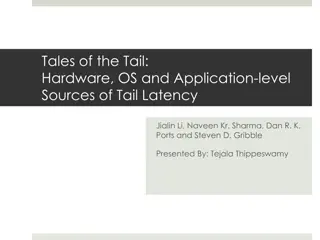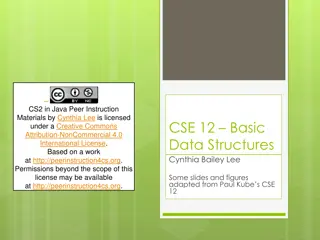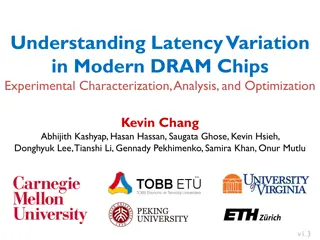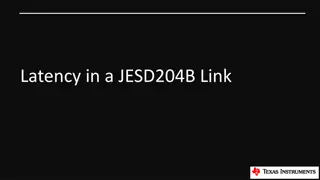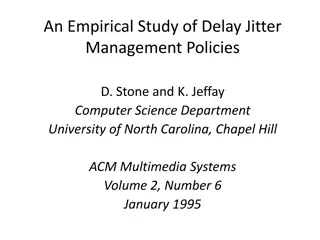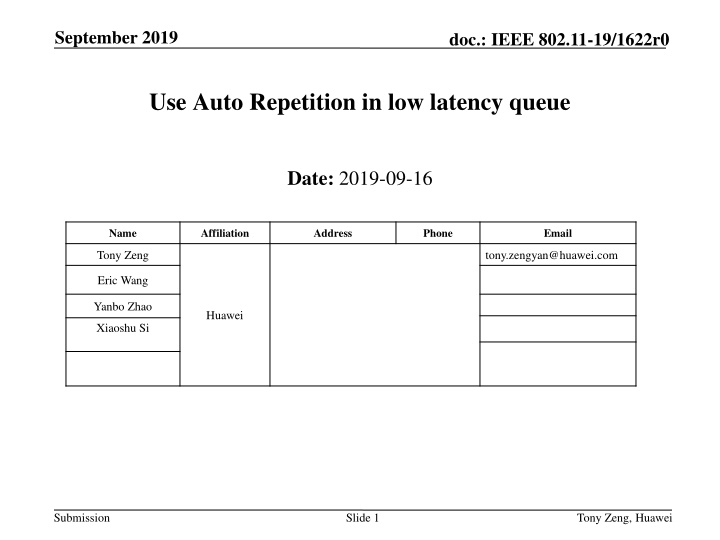
IEEE 802.11-19/1622r0: Auto Repetition for Low Latency in Multi-Link Operation
Introducing Auto Repetition (AR) mode designed for low latency flows in multi-link operations, ensuring better reception possibilities for streams requiring low latency. This mechanism aims to achieve bounded latency and jitter in transmission, enhancing QoS for real-time applications like gaming, robotics, and video streaming.
Download Presentation

Please find below an Image/Link to download the presentation.
The content on the website is provided AS IS for your information and personal use only. It may not be sold, licensed, or shared on other websites without obtaining consent from the author. If you encounter any issues during the download, it is possible that the publisher has removed the file from their server.
You are allowed to download the files provided on this website for personal or commercial use, subject to the condition that they are used lawfully. All files are the property of their respective owners.
The content on the website is provided AS IS for your information and personal use only. It may not be sold, licensed, or shared on other websites without obtaining consent from the author.
E N D
Presentation Transcript
September 2019 doc.: IEEE 802.11-19/1622r0 Use Auto Repetition in low latency queue Date: 2019-09-16 Authors: Name Affiliation Address Phone Email Tony Zeng tony.zengyan@huawei.com Eric Wang Yanbo Zhao Huawei Xiaoshu Si Submission Slide 1 Tony Zeng, Huawei
September 2019 doc.: IEEE 802.11-19/1622r0 Abstract In this contribution, we introduce Auto Repetition (AR) mode which is designed dedicatedly to low latency flow in the multi-link operation. In the multi-link operation, for a better QoS, one link can be dedicated for streams which need low latency. For such low latency streams, the link can be operated in an AR mode to guarantee a better reception possibility of the streams. Submission Slide 2 Tony Zeng, Huawei
September 2019 doc.: IEEE 802.11-19/1622r0 Introduction Recap1: The RTA-TIG recognizes that the worst-cast latency is the major challenge for real-time applications [1]. Some potential technical features are considered: predicable and efficient medium access, TSN extension, coordination between APs/BSS, and multi-link operation. Recap2: A new low latency queue is recommended for latency critical traffic, especially for the less frequent and small packet [2]. Based on these ideas, the contribution further proposes a mechanism to enable an bounded latency and jitter in the transmission by using auto repetition mode. Submission Slide 3 Tony Zeng, Huawei
September 2019 doc.: IEEE 802.11-19/1622r0 Bounded latency and jitter Latency+jitter <15ms [1] Latency+jitter <100ms [1] Real-time gaming Robotics (Drone control) Cloud gamming Real-time video Reality: Applications require different QoS for latency and jitter Requirement: 1. Multiple low latency queues may be required 2. A bounded latency and jitter may be required Latency budget Latency budget Low latency queue Time Entry of Packet #1 Entry of Packet #2 Submission Slide 4 Tony Zeng, Huawei
September 2019 doc.: IEEE 802.11-19/1622r0 Current re-transmission Trigger for re-transmission in many communication systems: 1. No ACK 2. NACK Issues: 1. ACK frame can be lost due to collision or interference, especially in a high packet loss environment 2. Timeout normally exceed the latency boundary requirement Active transmission mechanism is necessary 1. Redundant, active and repeated transmission 2. Robustness is enhanced by repetition frequency and spreading over time Submission
September 2019 doc.: IEEE 802.11-19/1622r0 Auto repetition Definition: Actively transmit a packet repeatedly according to dedicated rules. Goal: 1. To achieve a number of transmission for same packet within a time boundary in order to achieve zero packet error rate in 802.11 link 2. To transmit a packet in an exact time stamp to avoid a low-latency packet stuck in the transmission and RTX queue Advantages: 1. Significantly decrease packet loss in the 802.11 link to avoid packet re- transmission in the upper layer. 2. Increase the possibility that the packet will be correctly received. PHY Assuming 4 repetition is required Expected latency Fourth sent time First sent Second sent Third sent Submission Slide 6 Slide 6 Tony Zeng, Huawei Tony Zeng, Huawei Packet enters the TID queue
September 2019 doc.: IEEE 802.11-19/1622r0 Schematic New TID M? TID 0-7 Add new TID M or reuse TID 7 (as am example) for extreme low latency services. EDCA mechanism is kept while TID M is mapped to low latency link . MPDU [(A)-MSDU] EDCA queue Modified EDCA mechanism PHY processing In multi-link operation, a dedicated link can be allocated for low latency transmission Low Latency Link 3 Normal Link 1 & 2 Submission Slide 7 Tony Zeng, Huawei
September 2019 doc.: IEEE 802.11-19/1622r0 Schematic AQ queue replace Rtx Queue Modified EDCA Queue 1. MPDU/A-MPDU enter the AR Queue in the first transmission. 2. QoS requirement (i.e. latency budget), repetition number (# N) are configured 3. How to allocate the sending time is vendor discretionary. 4. The MPDU packet is sent repeatedly by N times during the latency budget. TID M MPDUN Enter the queue Not finished repeated send: re-enter the queue MPDU7 MPDU6 MPDU5 MPDU3 MPDU4 MPDU2 MPDU1 First time to send Repeated send MUX PHY Assuming 4 repetition is required Expected latency Fourth sent time First sent Second sent Third sent Submission Slide 8 Tony Zeng, Huawei Packet enters the TID queue
September 2019 doc.: IEEE 802.11-19/1622r0 How to establish new TID and EDCA queue How to create a TID queue: 1. Method 1: RE-use the current TID: By exchanging a management message to confirm an existed TID is used for AR purpose. 2. Method 2: To add new bits in the MAC Frame. What re the changes for EDCA queue 1. The current access mechanism of EDCA needs to be modified to adapt to the concept of AR: consolidated backoff are required 2. Each packet in this new queue needs to have its own countdown counter 3. The countdown may be determined by the expected latency boundary and repetition number 4. The EDCA queue can be dynamically created or re-use the current EDCA queue. Submission Slide 9 Tony Zeng, Huawei
September 2019 doc.: IEEE 802.11-19/1622r0 Example in multi-band for low latency queues Low latency Queue (modified EDCA Queue) Normal EDCA Queues AR Queue RTX Queue MUX MUX AR path Low latency band Link #1 Link #2 RTX path QoS #1~m are low latency (e.g., <= x ms budget from Tx to Rx) required streams The x ms latency is longer than the typical value of the round- trip latency (e.g., the mean value of the round-trip latency) Apply retransmission based on ACK for this Class is meaningless because the first RTX will probably exceed x ms The streams in this Class MUST be auto repeated by the transmitter at N times in total (where N is configured) The transmitter may conduct the last chance transmission to increase gain form the time diversity The receiver should not ACK the packets in this AR path (unless it has special reason to do so). The transmitter shall not resend the packets that are ACKed. QoS #m+1~n are normal latency (e.g. > y ms budget from Tx to Rx) required streams The ACK is expected to be received in less than y ms in statistic aspect (e.g. with respect to the mean value) Normal RTX based on ACK is applied Last chance auto repetition MAY also be applied in this path to increase the reception possibility in transmitter discretion Submission Slide 10 Tony Zeng, Huawei
September 2019 doc.: IEEE 802.11-19/1622r0 Consideration on multiple low latency queues Low latency streams should be classified into different low latency queues. Each queue should be specified by QoS parameters, such as Tx-to-Rx latency value. To further improve the robustness, repetition characteristics should be flexible, including repetition frequency, timing for last transmission. For both the AR path and RTX path, the receiver must preserve the packet order to convey them to the upper layer. The time stamp for the first transmission shall be kept in the further auto repetition or retransmission for the receiver to decide when to convey the packet to the upper layer. Buffering and re-ordering of the low latency packet are required in the receiver side. Submission Slide 11 Tony Zeng, Huawei
September 2019 doc.: IEEE 802.11-19/1622r0 Advantages Low Tx-to-Rx latency queue brings better performance in latency guaranteed for time sensitive service. By making use multi-link operation, to arrange a link for latency sensitive service further reduce the averaging transmission time and jitter because Low latency packets needn t compete with other packets which are not latency sensitive. Auto repetition enable an active and create a latency-jitter boundary for dedicated packet in specific queues. Submission Slide 12 Tony Zeng, Huawei
September 2019 doc.: IEEE 802.11-19/1622r0 Straw Poll #1 Do you support to specify the Auto-Repetition (AR) mode for packet transmission? Submission Slide 13 Tony Zeng, Huawei
September 2019 doc.: IEEE 802.11-19/1622r0 Straw Poll #2 Do you support that the low latency TID should be created for latency sensitive packets? Submission Slide 14 Tony Zeng, Huawei
September 2019 doc.: IEEE 802.11-19/1622r0 Straw Poll #3 Do you support that the number of repetitions in the AR mode can be configured? Submission Slide 15 Tony Zeng, Huawei
September 2019 doc.: IEEE 802.11-19/1622r0 References [1] Kate Meng, 11-19-0065-06-0rta-rta-tig-summary-and-recommendations [2] Kate Meng, 11-19-1175-00-00be-considerations-of-new-queue-mechanisms-for-real-time- applications , Submission Slide 16 Tony Zeng, Huawei
September 2019 doc.: IEEE 802.11-19/1622r0 Thank you Submission Slide 17 Tony Zeng, Huawei



